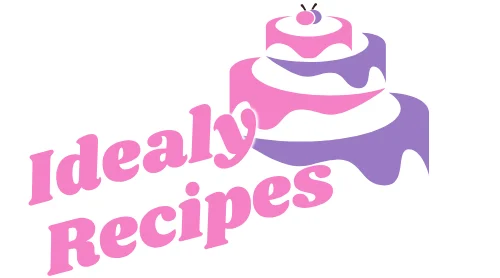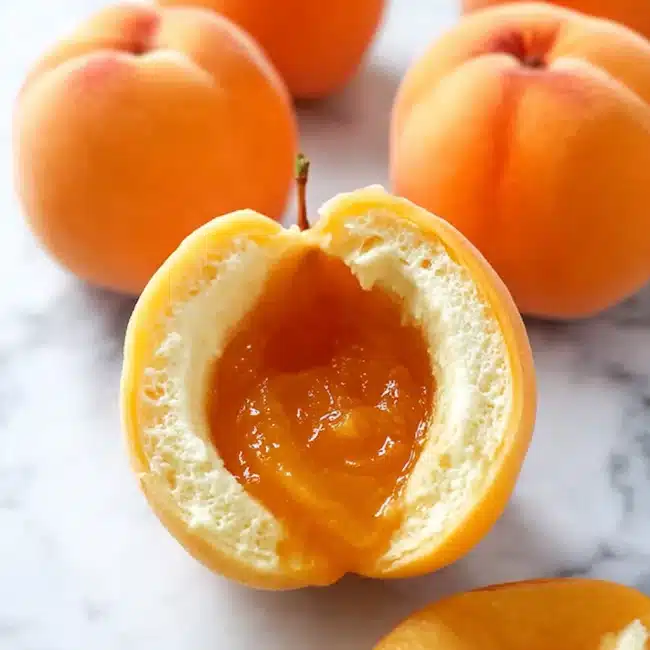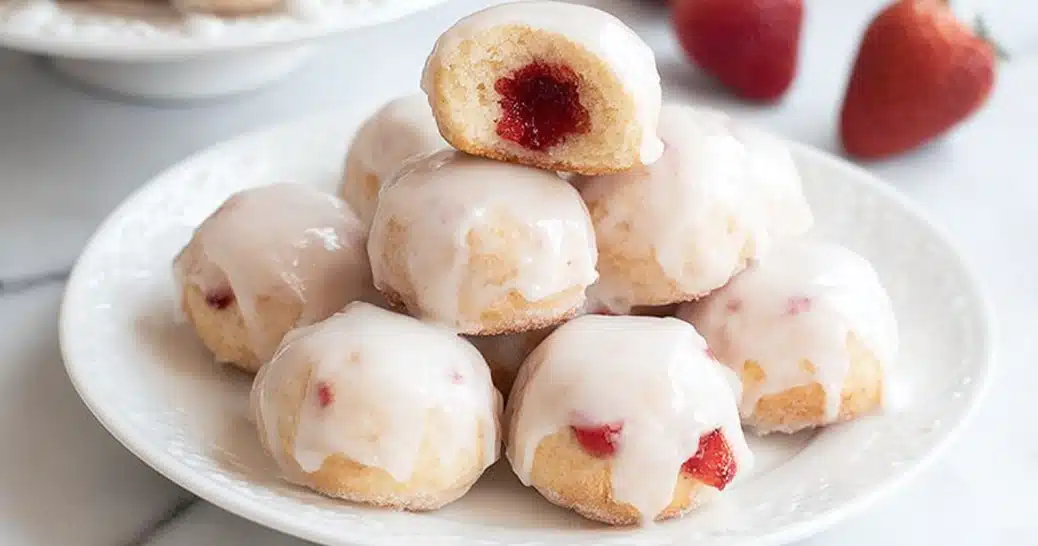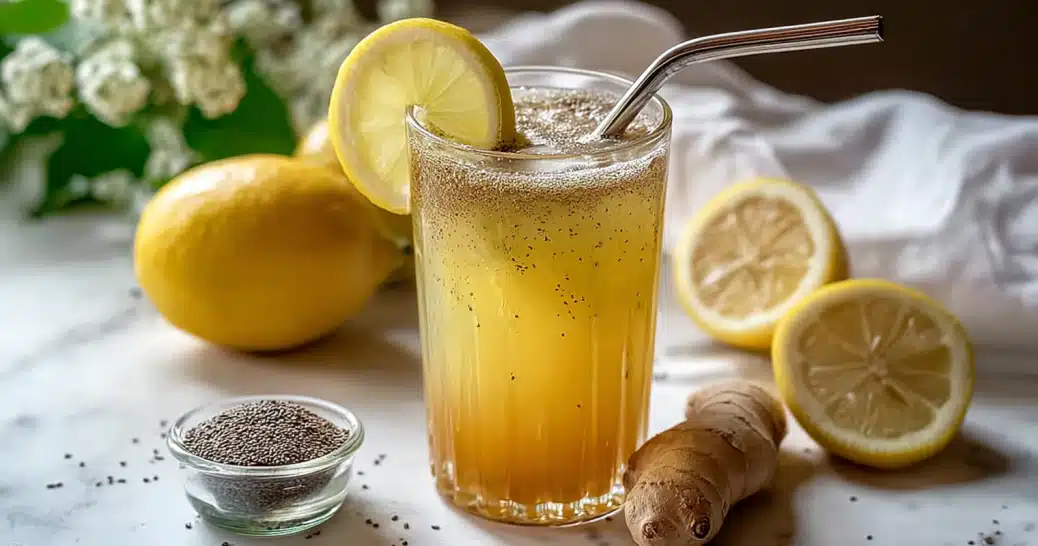Fruit shaped pastries are one of the most fascinating food trends today. At first glance, they look exactly like fresh fruit, but the surprise comes with the first bite. Instead of a juicy peach or mango, you get smooth mousse, creamy ganache, or sweet mung bean paste. These edible creations combine the worlds of baking, candy making, and visual art, making them as fun to admire as they are to eat.
The popularity of fruit shaped desserts has skyrocketed thanks to social media platforms like TikTok and Instagram. Videos showing realistic strawberries, apples, and peaches that turn out to be mousse or jelly have gained millions of views. People love the shock factor and the craftsmanship that goes into every piece. Whether it’s a Thai luk chup candy or a modern European peach mousse cake, fruit shaped pastries are proving that desserts can be both playful and sophisticated.
What makes them truly special is the mix of tradition and innovation. Luk chup, a Thai royal treat made from mung bean paste, has inspired a whole generation of pastry chefs to reimagine fruit as dessert. Now you’ll find fruit shaped pastries in bakeries across the world, at weddings, or as edible gifts that double as art pieces.
In this guide, you’ll discover everything about these realistic treats, from how they’re made to recipes you can try at home. We’ll cover the history of fruit desserts, explore viral creations, share plating ideas, and dive into detailed recipes that turn ordinary ingredients into extraordinary illusions. By the end, you’ll know exactly how to impress your guests with desserts that look like they belong in a gallery.
Table of Contents

Fruit Shaped Pastries: How To Make These Viral Desserts At Home
- Total Time: 1 hour 15 minutes
- Yield: 6 peach shaped pastries 1x
- Diet: Vegetarian
Description
A peach-shaped dessert with marmalade, ganache, and velvet finish.
Ingredients
Fresh ripe peaches (peeled)
1 tsp lemon juice
Lime juice
Sugar
Pectin
Crème de Pêche Divina (optional)
White chocolate (chopped)
Heavy cream (divided)
Fresh lemon verbena (optional)
Softened gelatin
Silicone peach molds
White chocolate (for glaze)
Cocoa butter (for glaze)
Instructions
1. Peel peaches, purée with lemon juice, heat with sugar and pectin.
2. Cool and freeze peach purée in molds to form cores.
3. Make white chocolate ganache with cream, verbena, and gelatin.
4. Whip ganache, fill molds, insert frozen cores, freeze again.
5. Detail peaches with knife, glaze in chocolate and cocoa butter.
6. Finish with velvet spray for realism.
Notes
Use high-quality silicone molds for best results.
Velvet spray creates a realistic peach skin finish.
Serve chilled for the best texture.
- Prep Time: 1 hour
- Cook Time: 15 minutes
- Category: Dessert
- Method: Frozen, Molded
- Cuisine: Modern European
Nutrition
- Serving Size: 1 peach dessert
- Calories: 220
- Sugar: 18g
- Sodium: 25mg
- Fat: 14g
- Saturated Fat: 9g
- Unsaturated Fat: 4g
- Trans Fat: 0g
- Carbohydrates: 24g
- Fiber: 1g
- Protein: 3g
- Cholesterol: 20mg
History and Cultural Influence of Fruit Shaped Desserts
Fruit shaped pastries may look like a modern invention, but the idea of creating sweets that mimic real fruit has deep cultural roots. In Thailand, luk chup has been crafted for centuries, originally as a delicacy for royalty. These miniature fruit candies, made from mung bean paste, coconut milk, and sugar, were shaped and painted to resemble mangoes, bananas, and cherries. The glossy finish came from an agar glaze, giving each piece a lifelike shine.
This tradition later inspired modern pastry chefs to experiment with fruit illusions. In Europe, marzipan shaped like fruit was popular in the Middle Ages. Both luk chup and marzipan reflect the human fascination with turning food into edible art. Today, fruit shaped pastries bring these traditions together while adding new techniques such as silicone molds, edible spray colors, and velvet finishes.
The cultural influence of these desserts also reflects celebration and artistry. They were often reserved for festivals, royal banquets, or weddings, symbolizing prosperity, abundance, and creativity. That symbolic meaning still lives on, making fruit shaped desserts popular choices for special occasions.
The Role of Thai Luk Chup in Shaping the Trend
Among all fruit shaped desserts, luk chup remains the most iconic. The Thai treat is simple in ingredients but stunning in appearance. Its appeal lies in how versatile it is—each piece can be shaped into different fruits, painted in vibrant colors, and presented in decorative trays.
Luk chup also influenced today’s viral dessert trend. Food bloggers and TikTok creators often credit Thai candy as the inspiration for their realistic cakes and pastries. The concept of turning humble ingredients into detailed works of art has now spread far beyond Thailand, shaping how bakers and pastry chefs approach edible design.
Modern fruit shaped pastries, such as mousse cakes coated in white chocolate sprays or jelly domes glazed to look like real peaches, are a continuation of this tradition. What was once an exclusive royal dessert has become a global food trend.
Fruit Shaped Dessert Recipe (Step-by-Step)
Ingredients Needed for Peach-Shaped Dessert
Creating fruit shaped pastries at home may sound intimidating, but with the right tools and ingredients, it’s surprisingly manageable. The peach-shaped dessert recipe below blends fruity flavors with creamy textures while delivering a realistic look. Here’s what you’ll need:
Fruit Base and Filling
- Fresh ripe peaches (peeled)
- 1 tsp lemon juice
- A splash of lime juice
- Sugar
- Pectin
- Crème de Pêche Divina (optional, for flavor depth)
Ganache Layer
- White chocolate (roughly chopped)
- Heavy cream (divided into two portions)
- Fresh lemon verbena (optional, for infusion)
- Softened gelatin
Tools and Equipment
- High-quality silicone fruit molds (peach shaped)
- White chocolate and cocoa butter (for glaze)
- Paring knife (for detailing realistic features)
- Food-safe velvet spray (for a soft finish)
Step-by-Step Preparation Method with Pro Tips
Step 1: Prepare the Peach Purée
Boil the peaches briefly for 20 seconds, then transfer them to ice water. This makes peeling effortless. Purée the peeled peaches with lemon juice, strain, and cook with sugar and pectin. Let the mixture boil for 2 minutes, then cool. Add cubed peaches and Crème de Pêche before pouring into half-sphere molds. Freeze until solid.
Step 2: Form the Peach Centers
Seal the frozen halves into full peach-shaped spheres. Place them back in the freezer to firm up. These will serve as the surprise centers inside your dessert.
Step 3: Create the Ganache
Warm half of the cream and steep it with lemon verbena for 20 minutes. Strain over chopped white chocolate to melt it smoothly. Add gelatin, peach purée, the remaining cream, and Crème de Pêche. Chill the ganache overnight for best texture.
Step 4: Assemble the Desserts
Whip the chilled ganache until firm. Fill each peach mold halfway, insert the frozen peach centers, and cover with more ganache. Freeze until completely solid.
Step 5: Add Realistic Details
Score each peach lightly with a paring knife to mimic natural fruit lines. For the finish, dip each dessert in a glaze of melted white chocolate and cocoa butter. Finally, spray with velvet cocoa butter for that signature peach skin texture.
Pro Tips for Success
- Always use quality silicone molds to capture realistic shapes.
- Freeze thoroughly between each step to prevent layers from collapsing.
- For extra realism, add a mint leaf or small chocolate stem before serving.
Nutrition (per serving)
- Calories: 220
- Sugar: 18g
- Fat: 14g
- Protein: 3g
This recipe may take time, but the payoff is stunning. Each peach-shaped pastry looks like real fruit while delivering a creamy, refreshing flavor inside.
Fruit Shaped Dessert Ideas That Wow Guests
Creative Fruit Shaped Treats for Parties and Events
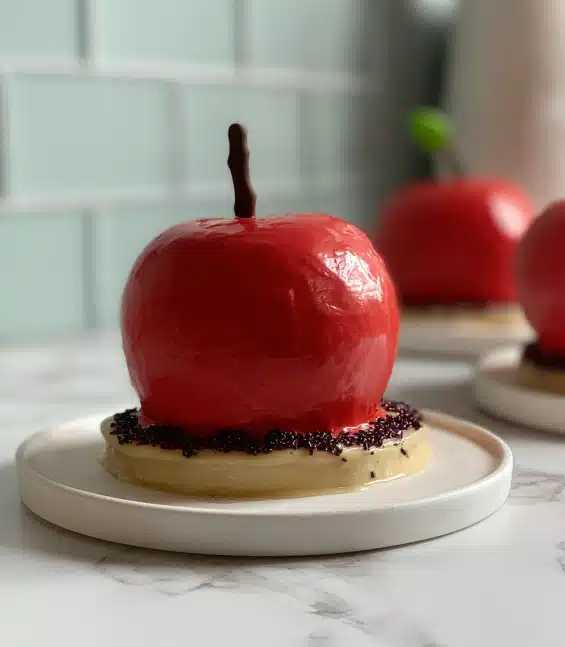
Fruit shaped pastries are more than desserts, they are conversation starters. Hosting a brunch, baby shower, or dinner party? These sweets instantly grab attention because they look like fresh fruit but surprise guests with unexpected flavors inside. Simple options like fruit-shaped mochi, gelatin molds, or even decorated cake pops are easy to prepare and still make a big impact.
For kids’ parties, try transforming donut holes into mini apples or peaches using red or orange icing with a fondant leaf. For more elegant events, mousse domes shaped like mangoes or apples work beautifully. With just a little creativity, you can design pastries that suit both casual gatherings and upscale celebrations.
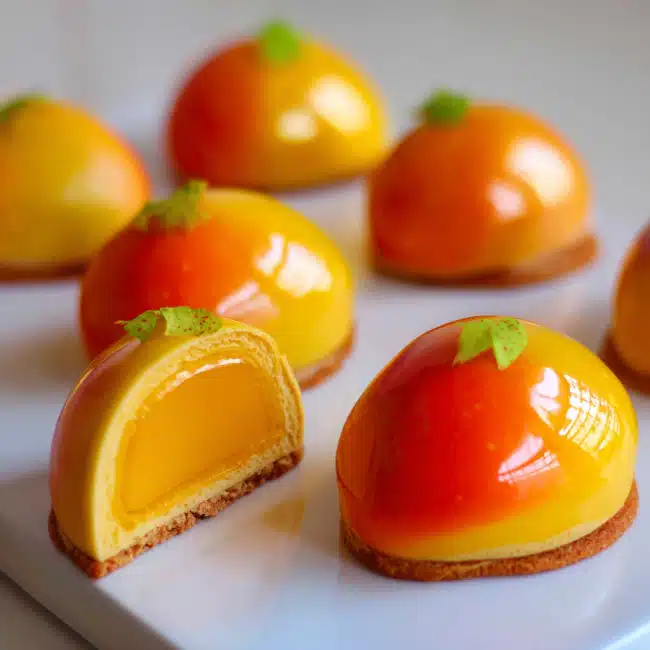
Plating and Presentation Tips for Maximum Impact
Presentation enhances the illusion. Place your fruit shaped pastries in shallow wooden boxes, wicker baskets, or ceramic bowls to mimic a freshly picked look. Add sprigs of mint, basil, or edible leaves for realistic detail. Crushed cookies or graham crumbs sprinkled underneath can resemble soil, adding a playful effect.
If you’re preparing a dessert table, vary the heights of your pastries using risers or stands. This creates visual depth and ensures every guest notices the details. Individual servings in mini baskets or wrapped in parchment paper also work well for favors and gifts.
Dessert Designs Inspired by Real Fruit
When designing fruit shaped desserts, three elements matter most: shape, color, and texture. Use molds for consistency, edible gel colors for natural tones, and finishing sprays for texture. For citrus fruits, lightly score the surface to mimic real skin. For berries, add tiny dimples or seeds with chocolate or edible powder.
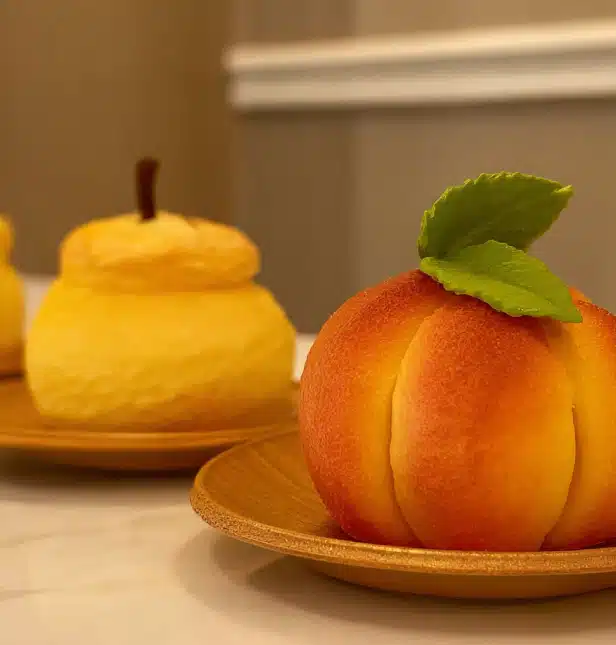
Small touches go a long way. A glossy apple glaze, a dusting of edible shimmer on grapes, or a velvet coating on peaches can transform a basic pastry into a hyper-realistic creation. These design details turn ordinary desserts into edible art that surprises and delights.
Popular Fruit Shaped Desserts Around the World
Viral Fruit Desserts on TikTok and Instagram
Social media has played a huge role in making fruit shaped pastries a global trend. On TikTok and Instagram, creators share mesmerizing videos of strawberries that cut open to reveal mousse layers, apples with caramel centers, and bananas made from jelly that peel like the real thing. These short clips capture millions of views because they mix visual trickery with the joy of dessert.
One standout viral creation is the strawberry mousse cake with a glossy glaze, complete with tiny dimples to mimic seeds. Another is the peach mousse dome that looks exactly like a ripe peach, only to reveal cream and marmalade inside. The hashtag #fruitdessert has become a hub for pastry lovers, artists, and curious foodies who want to try making their own.
Regional Variations of Fruit Shaped Sweets
While Thailand’s luk chup is the most traditional example, fruit shaped desserts appear in many cultures. In Japan, wagashi artisans craft sweets shaped like seasonal fruits and flowers, often using rice flour and bean paste. In Europe, marzipan has long been molded into pears, apples, and oranges, with vibrant painted details.
In modern patisseries, mousse cakes shaped like tropical fruits have become a signature of French-inspired pastry art. In the United States, bakeries in cities like New York and Los Angeles offer hyper-realistic fruit cakes and candy, often blending Asian and European influences. These desserts highlight how a simple concept can take on different forms depending on cultural style, ingredients, and technique.
How to Make Fruit Shaped Pastries at Home
Tools and Molds Needed for Realistic Results
Making fruit shaped pastries at home may look advanced, but with the right tools, anyone can do it. The most important item is a high-quality silicone mold shaped like fruits such as peaches, apples, or strawberries. These molds give the dessert structure and help you achieve a lifelike finish.
Other helpful tools include fine paintbrushes for edible colors, fondant sculpting tools for details, and food-safe airbrushes or velvet sprays for texture. If you prefer a more hands-on approach, toothpicks, melon ballers, or spoons can also create natural shapes and dimples.
Investing in a few molds and brushes is enough to get started. Once you master the basics, you can expand into advanced tools like edible powder shimmers, cocoa butter sprays, and precision cutters to mimic stems and leaves.
Common Mistakes to Avoid for Beginners
The biggest mistake when making fruit shaped pastries at home is rushing the process. Each stage, from molding to freezing to glazing, requires patience. Skipping freezing time often leads to collapsing layers or distorted shapes.
Another common error is overmixing or overcooking fillings like mung bean paste, which can make them crumbly instead of smooth. Beginners should also be careful with food coloring. Using too much liquid dye can cause colors to bleed and ruin details. Instead, start with concentrated gel or powder colors and build up in thin layers.
Finally, remember that less is often more. Small details such as a natural blush of red on a peach or a tiny mint leaf can make a bigger impact than heavy decorations. With practice, you’ll learn to balance artistry with simplicity.
All About Luk Chup: The Thai Fruit Candy
Origins of Luk Chup in Thai Royal Cuisine
Among all fruit shaped pastries, luk chup holds a special place in history. This Thai dessert dates back to the Ayutthaya period, when it was introduced to royal kitchens under Portuguese influence. Inspired by European marzipan, Thai chefs adapted the concept using local ingredients like mung beans, coconut milk, and sugar. The result was a colorful candy molded into tiny fruits, glazed for shine, and served at royal feasts.
Because of its intricate design and delicate flavors, luk chup quickly became associated with celebration and luxury. Each piece was carefully shaped into mini mangoes, bananas, or cherries, painted with natural dyes, and polished with a glossy finish. Today, it remains a symbol of artistry in Thai cuisine, passed down through generations of cooks and dessert makers.
What Makes Luk Chup Different from Marzipan
At first glance, luk chup looks similar to marzipan, but the two are quite different. Marzipan is made from almonds and sugar, giving it a dense, nutty flavor. Luk chup, on the other hand, uses mung bean paste blended with coconut milk, resulting in a smoother texture and lighter taste.
The sweetness level also sets them apart. Marzipan is rich and sugary, while luk chup is more subtle, often preferred by those who enjoy delicate desserts. Another key difference is the finishing touch. Luk chup is coated with a clear agar glaze that gives it a realistic shine, making it look like freshly picked fruit.
These differences explain why luk chup has become a viral favorite. Its lifelike appearance, vegetarian-friendly recipe, and cultural heritage make it both unique and accessible. For anyone exploring fruit shaped pastries, luk chup is the perfect starting point to understand how food can be both art and tradition.
Best Brands and Shops Selling Fruit Shaped Desserts
Where to Buy Fruit Shaped Pastries in NYC and LA
If you’re not ready to make fruit shaped pastries at home, the good news is that more bakeries and patisseries are offering them. In New York City, you’ll find mousse cakes shaped like peaches, lemons, and mangoes in Koreatown, while Chinatown is home to Thai dessert shops specializing in luk chup. Some high-end patisseries in Manhattan even create custom fruit-shaped mousse cakes that look so real, they often double as centerpiece art.
In Los Angeles, fruit shaped desserts thrive thanks to the city’s strong Asian food culture. Thai Town and Sawtelle are especially known for colorful luk chup trays and tropical fruit mousse domes. Upscale bakeries across the city also offer seasonal versions of these pastries, often packaged in luxury boxes, making them ideal as edible gifts.
Online Shops and Amazon Kits for DIY Desserts
Fruit shaped pastries aren’t limited to in-person bakeries. Online shops, including Amazon and Etsy, sell DIY kits and ready-made options. Popular luk chup kits include mung bean paste, edible colors, tiny brushes, and agar glaze powder, letting beginners try their hand at candy art. Many sellers also include video tutorials, which makes the process approachable even for first-timers.
If you’re looking for something already finished, online patisseries and specialty dessert shops offer nationwide shipping. These options often include mousse cakes shaped like apples or mangoes, packaged in insulated boxes to keep them fresh. Some companies even allow custom orders, perfect for weddings, baby showers, or corporate events.
Whether you shop locally or online, the key is freshness. Handmade pastries tend to taste better and look more realistic, while imported versions may be firmer and sweeter for longer shelf life. Both options have their appeal, but local shops usually win when it comes to authentic flavor and artistry.
Desserts That Look Like Real Fruit
Hyper-Realistic Pastry Designs
Some fruit shaped pastries are so lifelike that people hesitate before taking the first bite. These creations often appear in high-end patisseries or at international pastry competitions, where chefs showcase desserts that look exactly like apples, peaches, or grapes. The attention to detail is astonishing, with subtle dimples, shading, and gloss that mirror real fruit.
Instagram is filled with posts of hyper-realistic desserts, from shiny green apples with edible stems to strawberries dotted with hand-painted seeds. These sweets go viral because they blur the line between food and art, making them as photogenic as they are delicious.
Techniques Professionals Use for Lifelike Details
Achieving realistic fruit designs takes more than molds. Pastry chefs use airbrushing to create natural color gradients, edible powders to mimic texture, and velvet sprays to simulate skin-like finishes. For citrus fruits, tiny scoring marks are added to replicate pores, while chocolate stems and fresh mint leaves bring authenticity to peaches and plums.
Another technique involves edible glazes. A thin coat of gelatin or agar glaze provides a fresh-picked shine while sealing in moisture. For extra realism, chefs may layer different shades of color, starting light and adding depth with darker tones, just as real fruit ripens.
These techniques elevate fruit shaped pastries from simple desserts to edible illusions. Whether created for social media, weddings, or fine dining, they show how much artistry can be achieved with pastry tools and imagination.
Conclusion
Fruit shaped pastries are more than just desserts, they are edible works of art that capture attention before the first bite. From traditional Thai luk chup to hyper-realistic mousse cakes, these sweets prove that baking can be both creative and surprising. Their appeal lies in the balance of flavor, artistry, and illusion, making them perfect for parties, gifts, or simply enjoying at home.
With the rise of social media, fruit shaped pastries have gone from royal delicacies and regional traditions to global sensations. Whether you make them yourself with simple molds and edible colors or buy them from specialty shops, they offer a unique way to delight guests and spark conversations.
If you have not tried fruit shaped pastries yet, now is the perfect time. They are playful, elegant, and versatile, showing that food can be as beautiful as it is delicious. So the next time you want to impress friends or treat yourself, skip the ordinary and enjoy a dessert that looks like fruit but tastes even better.
FAQs
What is luk chup and why does it look like fruit?
Luk chup is a traditional Thai sweet that falls under the broader category of fruit shaped pastries. It is made from mung bean paste blended with coconut milk and sugar, then molded into tiny fruits like mangoes, cherries, or bananas. Each piece is painted with edible colors and coated with a clear agar glaze, giving it a shiny, realistic finish. This attention to detail makes luk chup look almost identical to real fruit.
Where can I buy fruit shaped desserts near me?
Fruit shaped pastries are becoming easier to find thanks to their growing popularity. In major cities like New York and Los Angeles, bakeries and Thai shops sell them regularly. Smaller towns may have them in Asian grocery stores or patisseries that specialize in artistic desserts. If you cannot find them locally, online shops and marketplaces like Amazon and Etsy often sell luk chup kits or ready-made fruit shaped sweets.
Are fruit shaped desserts made of real fruit?
Not usually. While some fruit shaped pastries may include fruit purées, jams, or marmalades inside, the outer design is typically created with ingredients such as mung bean paste, mousse, chocolate, or jelly. The realistic look comes from food coloring, molds, and finishing sprays, not from actual fruit skin.
How do I make luk chup at home without special molds?
Making luk chup at home without molds is possible. You can roll the mung bean paste into small balls or ovals by hand, then use toothpicks or sculpting tools to add details like dimples or tips. After shaping, paint them with food-safe gel colors and finish with a thin agar glaze. While molds help with consistency, handmade luk chup has a charm of its own.
What’s the difference between luk chup and marzipan?
Both luk chup and marzipan are popular examples of fruit shaped pastries, but their ingredients and flavors are very different. Marzipan uses ground almonds and sugar, resulting in a nutty and dense texture. Luk chup is made with mung beans and coconut milk, producing a smooth, light, and less sweet taste. Marzipan is common in Europe, while luk chup is a signature dessert in Thai cuisine.
